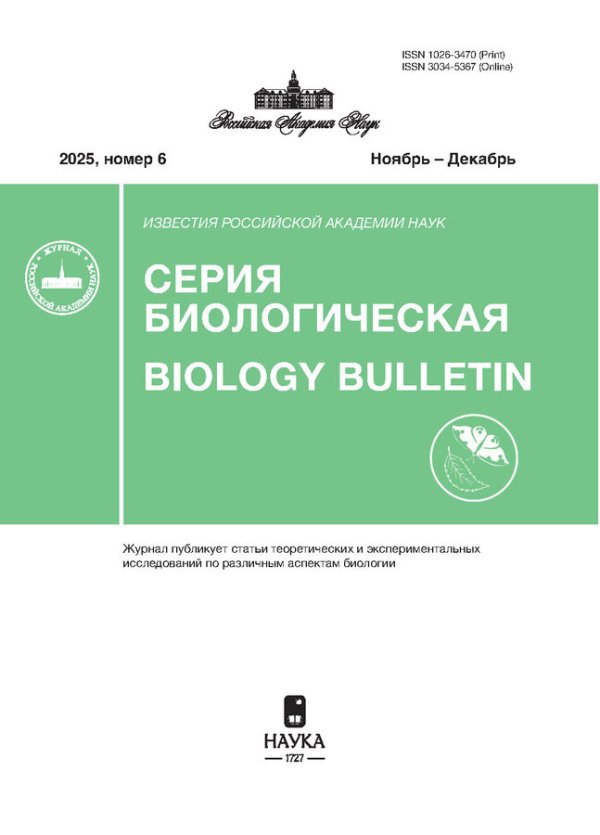Forest Biogeocenoses in the Area of Brown Forest Soils of the Western Caucasus
- Authors: Uligova T.S.1, Tsepkova N.L.1, Rapoport I.B.1, Gorobtsova O.N.1, Gedgafova F.V.1, Tembotov R.K.1
-
Affiliations:
- Tembotov Institute of Ecology of Mountain Territories of RAS
- Issue: No 1 (2023)
- Pages: 80-92
- Section: ECOLOGY
- URL: https://journals.rcsi.science/1026-3470/article/view/135507
- DOI: https://doi.org/10.31857/S1026347023010134
- EDN: https://elibrary.ru/INDNZM
- ID: 135507
Cite item
Full Text
Abstract
Vegetation and brown forest soil of different types of forests of the southern and northern macroslopes of the Main Caucasian Ridge were studied, special attention was paid to soil fauna (earthworms), microbial and enzymatic activity. A comparative analysis of the main components of forest biogeocenoses (plant communities, earthworms, microbial and enzymatic activity of the soil) of the southern and northern macroslopes of the Main Caucasian Ridge located in the Caucasian State Natural Biosphere Reserve and natural monuments “Guam Gorge” and “Colchian boxwood Massif” was carried out. The assessment of the plant diversity of various types of colchian forests of the southern and northern macroslopes is given. The similarity of the structure of plant communities, the population of earthworms, their species richness, as well as the most important indicators of the biological activity of the soil of the southern and northern macroslopes has been established. A close correlation between the indicators of biological activity of brown forest soil with the diversity of vegetation and the number of earthworms is shown.
About the authors
T. S. Uligova
Tembotov Institute of Ecology of Mountain Territories of RAS
Email: tembotov.rustam@mail.ru
Russia, 360051, Каbаrdinо-Ваlkаr Rерubliс, Nаlсhik, I. Armand street, 37-a
N. L. Tsepkova
Tembotov Institute of Ecology of Mountain Territories of RAS
Email: tembotov.rustam@mail.ru
Russia, 360051, Каbаrdinо-Ваlkаr Rерubliс, Nаlсhik, I. Armand street, 37-a
I. B. Rapoport
Tembotov Institute of Ecology of Mountain Territories of RAS
Email: tembotov.rustam@mail.ru
Russia, 360051, Каbаrdinо-Ваlkаr Rерubliс, Nаlсhik, I. Armand street, 37-a
O. N. Gorobtsova
Tembotov Institute of Ecology of Mountain Territories of RAS
Email: tembotov.rustam@mail.ru
Russia, 360051, Каbаrdinо-Ваlkаr Rерubliс, Nаlсhik, I. Armand street, 37-a
F. V. Gedgafova
Tembotov Institute of Ecology of Mountain Territories of RAS
Email: tembotov.rustam@mail.ru
Russia, 360051, Каbаrdinо-Ваlkаr Rерubliс, Nаlсhik, I. Armand street, 37-a
R. Kh. Tembotov
Tembotov Institute of Ecology of Mountain Territories of RAS
Author for correspondence.
Email: tembotov.rustam@mail.ru
Russia, 360051, Каbаrdinо-Ваlkаr Rерubliс, Nаlсhik, I. Armand street, 37-a
References
- Ананьева Н.Д. Микробиологические аспекты самоочищения и устойчивости почв. М.: Наука, 2003. 223 с.
- Андреев А.В. Оценка биоразнообразия, мониторинг и экосети. Кишинев. BIOTICA, 2002. 167 с.
- Аринушкина Е.В. Руководство по химическому анализу почв. М.: МГУ, 1970. 487 с.
- Ацци Д. Сельскохозяйственная экология. М.: Агропромиздат, 1959. 479 с.
- Бибин А.Р., Ковалев В.В. Опыт борьбы с самшитовой огневкой Cydalima perspectalis (Walker, 1859) (Lepidoptera Crambidae) на Северо-Западном Кавказе // Материалы VI Всерос. конф. с международным участием “Экология: рациональное природопользование и безопасность жизнедеятельности”. Майкоп, 2017. 19–22 октября. С. 15–18.
- Вадюнина А.Ф., Корчагина З.А. Методы исследования физических свойств почв и грунтов. М.: Высшая школа, 1961. 345 с.
- Всеволодова–Перель Т.С. Дождевые черви фауны России. М.: Наука, 1997. 102 с.
- Высоцкий Г.Н. Дождевой червь: избранные сочинения. Т. 2. М.: Изд-во АН СССР. 1962. С. 19–28.
- Гавриленко Е.Г., Ананьева Н.Д., Макаров О.А. Оценка качества почв разных экосистем (на примере Серпуховского и Подольского районов Московской области) // Почвоведение. 2013. № 12. С. 1505–1515.
- Гапонюк Э.И., Малахов С.В. Комплексная система показателей экологического мониторинга почв // Тр. Всесоюз. совещ. Обнинск, июнь 1983. Л.: Гидрометеоиздат, 1985. С. 3–10.
- Гераськина А.П., Шевченко Н.Е. Биотопическая приуроченность дождевых червей в малонарушенных лесах Тебердинского биосферного заповедника // Лесоведение. 2018. № 6. С. 464–478.
- Гиляров М.С. Учет крупных почвенных беспозвоночных (мезофауны) // Методы почвенно-зоологических исследований. М.: Наука, 1975. С. 12–29.
- Горобцова О.Н., Улигова Т.С., Гедгафова Ф.В., Темботов Р.Х., Хакунова Е.М. Биологическая активность почв в поясе широлиственных лесов Центрального Кавказа // Лесоведение. 2021. № 1. С. 1–15.
- Добровольский Г.В., Чернов И.Ю. (ред.). Роль почвы в формировании и сохранении биологического разнообразия. М.: Товарищество научных изданий КМК, 2011. 273 с.
- Егоров В.В., Иванова Е.Н., Фридланд В.М. Классификация и диагностика почв СССР. М.: Колос, 1977. 224 с.
- Зернов А.С. Флора Северо-Западного Кавказа. М.: Товарищество научных изданий КМК, 2006. 664 с.
- Зонн С.В. Горно-лесные почвы Северо-Западного Кавказа. М.–Л.: АНСССР, 1950. 336 с.
- Казеев К.Ш., Колесников С.И. Биодиагностика почв: методология и методы исследований. Ростов-на-Дону: Изд-во Южного Федерального ун-та, 2012. 258 с.
- Казеев К.Ш., Колесников С.И., Вальков В.Ф. Биология почв Юга России. Ростов-на-Дону: Изд-во ЦВВР, 2004. 350 с.
- Климатические данные городов по всему миру. 2015. https://doi.org/climate-data.org/
- Красная книга Российской Федерации (растения и грибы). М.: Товарищество научных изданий КМК, 2008. 855 с.
- Лазук П.Д. Типы леса хостинской заповедной рощи // Труды Кавказского государственного заповедника. 1960. Вып. 6. С. 66–86.
- Лакин Г.Ф. Биометрия. М.: Высшая школа, 1980. 293 с.
- Лукина Н.В., Исаев А.С., Крышень А.М., Онучин А.А., Сирин А.А., Гагарин Ю.Н., Барталев С.А. Приоритетные направления развития лесной науки как основы устойчивого управления лесами // Лесоведение. 2015. № 4. С. 243–254.
- Лукина Н.В., Орлова М.А., Бахмет О.Н., Тихонова Е.В., Тебенькова Д.Н., Казакова А.И., Крышень А.М., Горнов А.В., Смирнов В.Э., Шашков М.П., Ершов В.В., Князева С.В. Влияние растительности на характеристики лесных почв Республики Карелия // Почвоведение. 2019. № 7. С. 827–842.
- Мещерякова Е.Н., Берман Д.И. Устойчивость к отрицательным температурам и географическое распространение дождевых червей (Oligochaeta, Lumbricidae, Moniligastridae) // Зоологический журн. 2014. Т. 93(1). С. 53–64. https://doi.org/10.7868/S0044513414010127
- Мэгарран Э. Экологическое разнообразие и его измерение. М.: Мир, 1992. 182 с.
- Неронов В.В. Полевая практика по геоботанике в средней полосе Европейской России. М.: Изд-во Центра охраны дикой природы, 2002. 140 с.
- Нечаев Ю.А. Лесные богатства Кабардино-Балкарии. Нальчик: Эльбрус, 1960. 143 с.
- Перель Т.С. Распространение и закономерности распределения дождевых червей фауны СССР. М.: Наука, 1979. 275 с.
- Разнообразие и динамика лесных экосистем России // Исаев А.С. (ред.). М.: Товарищество научных изданий КМК, 2012/ 2013. Кн. 1. 461 с. / Кн. 2. 478 с.
- Рапопорт И.Б. Высотное распределение дождевых червей (Oligochaeta, Lumbricidae) в центральной части Северного Кавказа // Зоологический журн. 2013. Т. 92(1). С. 3–10.
- Тимухин И.Н., Туниев Б.С. О границах Бело-Лабинского, Туапсе-Адлерского и Абхазского флористических районов Кавказа. Вест. Удмуртского Университета. 2016. Т. 26. Вып. 2. С. 91–97.
- Улигова Т.С., Гедгафова Ф.В., Горобцова О.Н., Цепкова Н.Л., Рапопорт И.Б., Темботов Р.Х., Хакунова Е.М. Луговые биогеоценозы субальпийского пояса Кабардино-Балкарского государственного высокогорного заповедника (Центральный Кавказ) // Nature Conservation Research. Заповедная наука. 2019. Т. 4 С. 29–47. https://doi.org/10.24189/ncr.2019.012
- Юсупов З.М. К фауне муравьев (Hymenoptera, Formicidae) Тебердинского государственного природного биосферного заповедника // Вест. АГУ. 2014. Вып. 4(147). С. 58–62.
- Adamczyk B., Simon J., Kitunen V., Adamczyk S., Smolander A. Tannins and their complex interaction with different organic nitrogen compounds and enzymes: Old paradigms versus recent advances // Chemistry Open. 2017. V. 6(5). P. 610–614.
- Anderson J.P.E., Domsch K.H. A physiological method for the quantitative measurement of microbial biomass in soils // Soil Biol. Biochem. 1978. V. 10(3). P. 215–221.
- Bauhus J., Pare D., Cote L. Effects of tree species, stand age and soil type on soil microbial biomass and its activity in a southern boreal forest // Soil Biology and Biochemistry. 1998. V. 30(8–9). P. 1077–1089.
- Bernier N., Gillet F. Structural relationships among vegetation, soil fauna and humus form in subalpine forest ecosystem: a hierarchical multiple factor analysis (HMFA) // Pedobiologia. 2012. V. 55(6). P. 321–334. https://doi.org/:10.1016/j.pedobi. 2012.06.004
- Breeman N., Fienzi A.C. Plant-soil interactions: ecological aspects and evolutionary implications // Biogeochemistry. 1998. V. 42. P. 1–19.
- Jacob M., Viedenz K., Polle A., Thomas F.M. Leaf litter decomposition in temperate deciduous forest stands with a decreasing fraction of beech (Fagus sylvatica) // Oecologia. 2010. V. 164: P.1083–1094. https://doi.org/10.1007/s00442-010-1699-9
- Hartley R.V.L. Transmission of information // Bell System Technical J. 1928. V. 7(3). P. 535–563. https://doi.org/10.1002/j.1538-7305.1928.tb01236.x
- Greiner H.G., Stonehouse A.M.T., Tiegs S.D. Cold tolerance among composting earthworm species to evaluate invasion potential // Amer. Midland Naturalist. 2011. V. 166. P. 349–357.
- Karmegam N., Daniel T. Effect of physico-chemical parameters on earthworm abundance: a quantitative approach // J. Appl. Sci. Res. 2007. V. 3(11). P. 1369–1376.
- Kooijman A.M., Cammeraat E. Biological control of beech and hornbeam affects species richness via changes in the organic layer, pH and soil moisture characteristics // Functional Ecology. 2010. V. 24(2). P. 469–477.
- Langenbruch Ch., Helfrich M., Flessa H. Effects of beech (Fagus sylvatica), ash (Fraxinus excelsior) and lime (Tilia spec.) on soil chemical properties in a mixed deciduous forest // Plant and Soil. 2012. V. 352. P. 389–403.
- Lavelle P., Bignell D., Lepage M., Wolters V., Roger P., Ineson P., Heal O.W., Dhillion S. Soil function in a changing world: the role of invertebrate ecosystem engineers // Eur. J. Soil Biology. 2006. V. 33. P. 159–193.
- Oostra S., Majdi H., Olsson M. Impact of tree species on soil carbon stocks and soil acidity in southern Sweden // Scandinavian J. Forest Res. 2006. V. 21. P. 364–371.
- Pielou E.C. Ecological Diversity. N.Y.: John Wiley and Sons, 1975. 165 p.
- Rapoport I.B., Tsepkova N.L. Earthworm Populations (Oligochaeta, Lumbricidae) in the Basin of the Middle Reaches of the Bol’shaya Laba River (Northwestern Caucasus, Buffer Zone of Caucasian Nature Reserve) // Biology Bulletin. 2019. 46(9). P. 12–29.
- Rutigliano F., Alfani A., Bellini L. et al. Nutrient dynamics in decaying leaves of Fagus sylvatica L. and needles of Abies alba Mill // Biology and Fertility of Soils. 1998. V. 27. P. 119–126. https://doi.org/10.1007/s003740050409
- Shannon C.E. A Mathematical Theory of Communication // Bell System Tech. J. 1948. V. 27(3). P. 379–423. https://doi.org/10.1002/j.1538-7305.1948.tb01338.x
- Simpson E.H. Measurement of diversity // Nature. 1949. V. 163. 688 p. https://doi.org/10.1038/163688a0
- Striganova B.R., Emets V.M., Starodubtseva E.A., Emets N.S. The recent trend of the biodiversity dynamic of biotic communities in forest-steppe oak forests // Biology Bulletin. 2001. V. 28(5). P. 508–516. /https://doi.org/10.1023/A:1016752429044
- Uligova T.S., Gorobtsova O.N., Tsepkova N.L., Rapoport I.B., Gedgafova F.V., Tembotov R.Kh. Ecological and biological studies in the haplic chernozems pacnic soils area in the Central Caucasus (Kabardino-Balkaria) // Biological Communications. 2017. V. 62(4). P. 244–255. https://doi.org/:10.21638/11701/spbu03.403
- Vesterdal L., Schmidt I., Callesen I., Nilsson L., Gundersen P. Carbon and nitrogen in forest floor and mineral soil under six common European tree species // For Ecol Manage 255. 2008. P. 35–48.
Supplementary files















